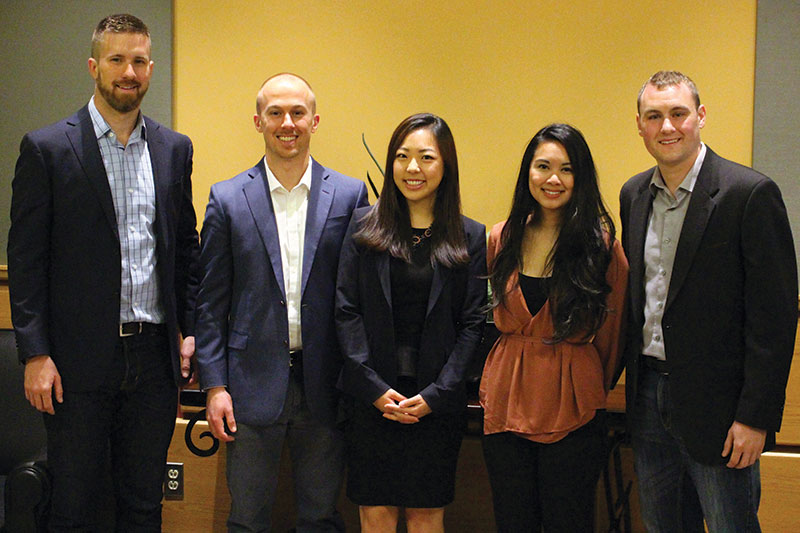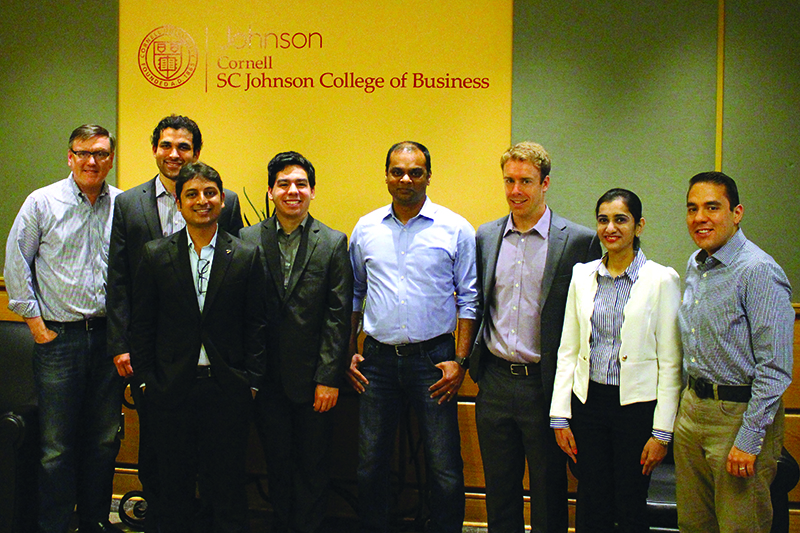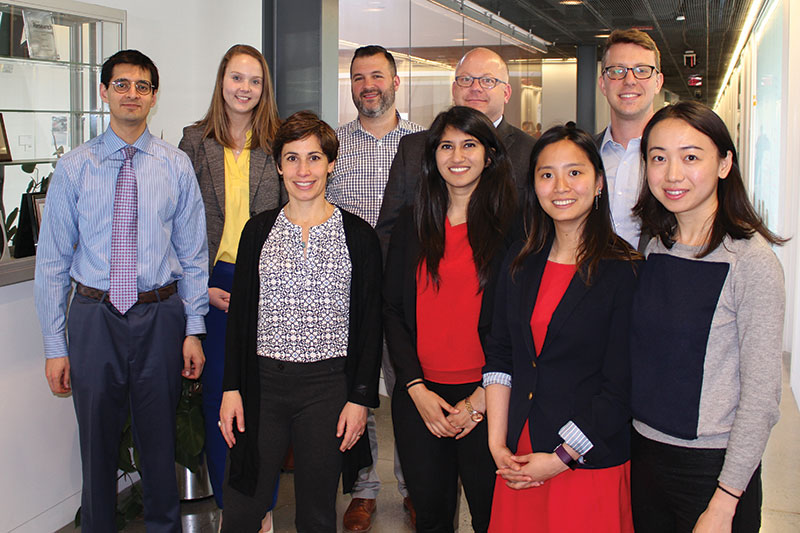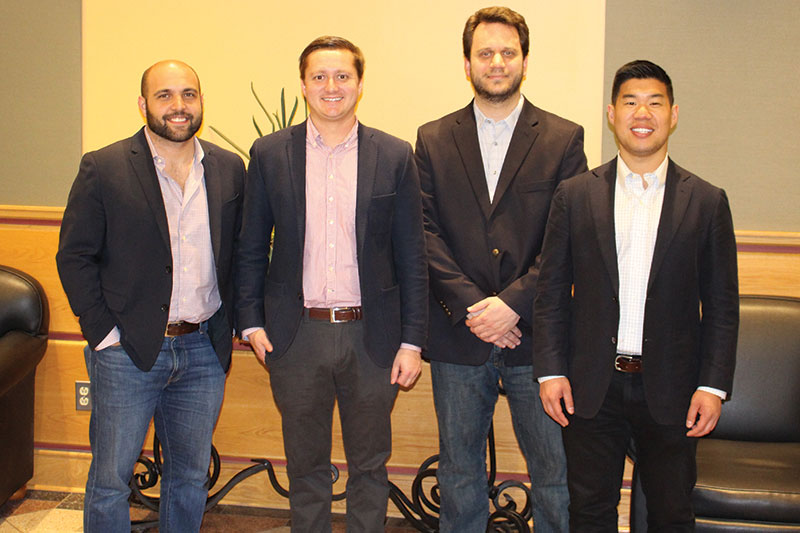Immersed in Digital Technology

Find out how students, alumni, and faculty in Ithaca and at Cornell Tech inspired and defined Johnson’s newest, interdisciplinary immersion: the Digital Technology Immersion.
Serendipitous. That’s the word that Associate Dean Vishal Gaur uses to describe the convergence of experiences, input, and evidence that brought about Johnson’s newest immersion, the Digital Technology Immersion.
When he taught at Cornell Tech in the fall of 2014, Gaur was impressed at the quality of interdisciplinary exchanges he witnessed among master’s in Computer Science, Engineering, and MBA students there. At the same time, a growing number of students in Ithaca were interested in preparing themselves for digital technology product management careers — so they were creating a combination of courses and technology projects for themselves as a customized immersion.
Two of them, High Tech Club officers Matt Hunt, MBA ’16, and Gbadebo (Debo) Aderibigbe, MBA ’16, took things a step further and did a survey of students in Ithaca to ask “What technology coursework do we need?” Then they approached Gaur about bringing “more interdisciplinary technology courses into the business school fold,” as Hunt put it. “We found great support from Associate Dean Vishal Gaur,” he wrote in his blog post the spring of 2015.
“Every company is affected by digital technology. Even manufacturing companies want to figure out how their products interact with their users.” — Vishal Gaur, associate dean for MBA programs and Emerson Professor of Manufacturing Management
“The first thing that I did after I met with those students was to go to the Information Science department and ask one of their faculty members to come and do a workshop for us,” says Gaur. “So the first year we just had a short, 1.5-credit course that was team taught by Information Science faculty who presented their research on different topics to our students. And it generated enrollments of between 50 and 70 students.” Clearly the demand from students was strong.
Next, Gaur and Hunt interviewed about 20 alumni — from both Information Science and Johnson — in Silicon Valley. And they confirmed that “the need was felt” for MBAs with a strong digital technology background, said Gaur. Soumitra Dutta, then dean of Johnson, gave Gaur the go-ahead to hire a new faculty member with expertise in digital technology to launch and lead the new immersion. “We went to the market and hired Shawn Mankad,” said Gaur. Mankad’s expertise is deeply rooted in the intersection between data analytics and economic decision making using machine-learning techniques. He joined Johnson’s faculty in August 2015 and “in the fall 2015 semester, we fleshed out the immersion,” says Gaur.
That’s when Mankad designed three new courses for the immersion, including Introduction to Statistical Programming and SQL (Structured Language Query, a standard language for storing, manipulating, and retrieving data in databases); Advanced Data Analytics Applications and Methods; and the Digital Technology Immersion (DTI) practicum — the hands-on aspect of the immersion, which includes guest lectures by industry leaders in digital technology plus a semester-long project sponsored by industry clients (see sidebar: Tech insights from DTI student projects).
Meanwhile, Gaur approached the chair of the Department of Information Science (IS), Thorsten Joachims, who turned out to be very interested in joint curriculum involving IS and Johnson students because: “Johnson is the biggest destination outside of Information Science for our master’s students,” the IS chair said.
“It seemed like it would be a very good idea to put those groups of students together in the same classroom,” says Gaur. “That was appealing.” Encouraged by the prospect of creating an interdisciplinary immersion, Gaur took his case to Gilly Leshed, senior lecturer and director of the Master of Professional Studies (MPS) program in the Department of Information Science, to ask her to co-teach in the immersion.
“Vishal contacted me about doing something together, saying ‘Our students are looking for some technical training. We want our students to get some knowledge of programming, processing data, and analyzing datasets,’” said Leshed. Gaur told Leshed about hiring Shawn Mankad, described the digital technology immersion as it was developing.
Leshed was game for the challenge and saw it as a win-win all around: She knew her MPS students would be interested in collaborating on projects with MBA students and welcomed the idea of MBA students taking information science classes that would count toward the immersion — which is exactly what happened. “For both of them, this resembles what they will be doing in the future: business people having to speak the engineering language and the engineers having to talk with those who make decisions in the business space,” Leshed says.
“Business people having to speak the engineering language and the engineers having to talk with those who make decisions in the business space.” — Gilly Leshed, senior lecturer, Department of Information Science
After launching the DTI, the number of students enrolled in the customized immersion dropped from 85 to between 25 and 30. Both of Mankad’s courses have become very popular overall — including among Johnson students not in the DTI: “They are realizing that they should do some of those courses,” Gaur says, “because every company is affected by digital technology. Even manufacturing companies want to figure out how their products interact with their users.”
Projects for the practicum: It takes a village
Getting projects for the DTI is a combined effort among the faculty, the Career Management Center, students, and external relations staff. “I reach out to our major gift officers and our gift leadership officers within Johnson, because they’re out there meeting our alumni,” says Candace Maxian, assistant director of public engagement in Johnson’s Office of External Relations — the person who pulls together leads from myriad sources and follows up on them. “It takes a lot of outreach — a whole team effort — to get good projects,” she says.
Maxian tells the companies she recruits projects from about who will be in their court if they submit a project for this immersion: a cross section of MBAs and MPS Information Science students, people who come from different industry backgrounds and different countries around the world who will look at a business challenge from a fresh perspective and find those out-of-the-box solutions.
It was easier to recruit companies for 2017, Maxian says, because “We had a track to run on.” In addition to the research, results, and recommendations they receive in a presentation at the conclusion of a project, Maxian adds that: “It’s an excellent opportunity for these companies to see students — potential employees — in a different light.”
Hunt, one of the High Tech Club officers who surveyed students about their interest in technology coursework in spring 2015, and who became a TA for the first DTI in spring 2016, also helped recruit companies for that first DTI. “He was an intern with IBM in summer 2015 and recruited IBM then,” says Maxian. “He also met reps from other companies, told them about the DTI, and got them interested.” Hunt is now a senior manager in analytics and technology product marketing at Workday.
Will Rodger, MBA ’17, a student in DTI spring 2016 and one of several to do their spring 2017 semester at Cornell Tech, was key to getting projects for DTI spring 2017. “Students go out to conferences and start networking,” says Maxian. “Because Will was in the Digital Technology Immersion the first year, he was able to help recruit a number of projects for this year. Will helped us get this year’s IBM, Qualtrics, and M&T Bank projects via networking at conferences, including the Johnson Women in Technology conference.”
Rodger was an ideal advocate for recruiting company projects because he values his own DTI experience so much. “The opportunity to work on an interdisciplinary team of MBAs and Information Science students and gain real-world, technical experience with an industry-leading company is what sets the DTI apart,” Rodger says. “I was truly amazed at how much we were able to accomplish as a team over the course of four months, and how much we were able to teach each other.”
“This year,” says Leshed, “we had a lot more knowledge around what counts as a successful project in terms of how to define it, how to scope it, how to present it to the students, and also how to define the relationships with the clients.”
Straight from the horse’s mouth
Right at the outset, Leshed and Mankad identified the topics they wanted guest speakers to cover, including software engineering and agile development, fintech and health tech, cloud computing and product management. “These evolved from just talking with alumni and current students about what they are interested in,” says Leshed.
Next, they searched their networks, and the networks of CIS and Johnson alumni, for who could deliver great guest lectures on these topics.
“We found some really engaging guest speakers,” says Leshed. “For example, Bill Arms, a professor emeritus in Computing and Information Science who comes back to teach a software engineering class every spring — he talks about software engineering to nontechnical people in the class in a way that’s eye-opening. We had a team come from Workday and talk to the students about cloud computing, because this is what they do at Workday.”
Leshed notes that both she and her Information Science students find it striking to see just how people-oriented MBA students are. “They look for more ways to interact both with the guest speakers and with the clients,” she says. “For MBAs, it’s a lot about getting to know them on a personal basis, on a career basis, learning from their experiences and from case studies.” To that end, when guest speakers and clients come to campus, Leshed and Mankad schedule opportunities for students to meet and interact with them outside of the classroom.
Several alumni came to speak on a product management panel in April, including Adam Beckwith ’14 (Information Science), software product manager at Matereality; Debo Aderibigbe, MBA ’16, senior product manager, technical products, at Amazon Web Service; Balu Rajagopal, MBA ’11, head of digital platforms at GenZe by Mahindra; and Matthew Hunt, MBA ’16, senior manager, analytics and technology product marketing at Workday.
Additional DTI speakers included Bob Lord, IBM chief digital officer, who spoke from deep experience about “Marketing and Technology.”Erica Dawson, director of the Cornell College of Engineering Leadership Program, led an intensive workshop and stress-inducing, timed, team-based exercise: “Team Dynamics and Conflict Resolution.” And Theomary Karamanis, senior lecturer of management education at Johnson, delivered a dynamic presentation filled with dos and don’ts about “Effective Presentation Strategies.”
The end game: DTI goals, outcomes
“I view my role as teaching people how to deal with data, to make them fluent in communicating with data scientists or statisticians, or even doing the modeling themselves to some extent,” says Mankad.
To that end, he has adjusted his teaching style to make abstract concepts tangible. “I come from a math statistics background; you write on the chalkboard, and examples may be a little bit dry,” says Mankad. “I found that students definitely learned a lot last year but then had some difficulty connecting what they were learning to what they were going to do on a day-to-day basis in their internships. So I restructured the course content in general. Now, instead of ‘Here’s a mathematical concept, and you figure out how to connect it to your world,’ I’ll present it like, ‘Here’s a task you will have to work on, a real problem in front of you, and here are the concepts that will help you solve this.’ Those adjustments seemed to really help a lot this year.”
Students certainly see the value: Enrollment has doubled from between 40 and 50 students in 2016 to 80 to 90 students in 2017. “It is kind of a good problem to have,” says Mankad. “It went well last year, and it’s going even better this year.”
Recruiters are on board, too. “There is a demand for this skillset of how to use data to make decisions across multiple types of functions and applications,” says Liz Arnold, associate director, high tech, entrepreneurship and venture capital in Johnson’s Career Management Center. “Most companies at this point are facing some sort of digital transformation challenge, and these skills can be applicable in so many different ways.”
Class of 2017 MBAs who took the DTI in 2016 now have jobs in product marketing, financial operations, tech product management, global technology strategy, and digital strategy consulting at Microsoft, Google, Amazon, McKinsey, Deloitte, and the Boston Consulting Group. Matt Hunt, MBA ’16, is now a senior product marketing manager in Analytics and Technology Product Marketing at Workday. Debo Aderibigbe, MBA ’16, is now a senior product manager, technical products, at Amazon Web Service. Both came back to campus as guest speakers for a DTI product management panel in April. Will Rodger, MBA ’17, is moving to California to work at a large technology company in a business development role.
Class of 2018 MBAs who took the DTI in 2017 are doing internships now in strategy and business development, tech product management, consulting, process transformation (how to improve processes from a technology standpoint), brand management, strategic marketing, and business strategy at some of the same brand-name companies, plus Corning, Cisco, eBay, PwC, and IBM Extreme Blue — a specialized leadership rotation internship. “It’s a good cross section,” says Arnold.
As more companies learn about Johnson’s DTI, reap the insights gained from DTI student consulting teams, understand how well prepared DTI graduates are, and see the caliber of jobs they are snatching up, the program generates more interest and attention. Because there’s no doubt about it: Recruiters in every type of company — large and small, tech-focused or not —are looking for MBAs with expertise in making sense of data and making data analysis actionable.
“There is a huge need for critical thinking and structured problem solving in the technology sector. Business schools breathe these skills.” — Matt Hunt, MBA ’16, senior product marketing manager, Workday
“The first thing one of the senior VPs at Workday said when I told her I had joined from Johnson was ‘Yes, we need more MBAs here!’” says Hunt. “There is a huge need for critical thinking and structured problem solving in the technology sector. Especially with emerging industries and business models, you need frameworks and modeling skills to organize themes and analyze what-if scenarios. Business schools breathe these skills.”
Inspired by Cornell Tech

“The Digital Technology Immersion borrowed the core idea of Cornell Tech: this multidisciplinary approach, where you have engineering and computer design and business students all working together,” says Mankad. “A lot of the inspiration comes from that. As for the curriculum — the way we help companies design projects for the practicum — we definitely had discussions with folks who do that in New York City to make sure we learned from their experiences.”
This summer, Mankad taught Introduction to Statistical Programming and SQL to Cornell Tech students in Ithaca. “Hopefully, over time, there will be more synergies,” he says.
“We have had the semester in Cornell Tech’s program for two years now,” notes Gaur. “And next year in the spring semester we’ll be able to send a much larger cohort: 50 to 60 students will have the option to spend a semester at Cornell Tech.”
Tech Insights from DTI Student Projects
As part of the Digital Technology Immersion practicum, student teams work for industry clients to address a technology-related challenge. They devise a project plan using data science, user-centered design, and information technology to research specific aspects of the challenge and deliver a final presentation and report. Clients come from a broad spectrum of companies — including IBM, Qualtrics, M&T Bank, Salesforce, Shutterfly, Verizon, and Workday, among others. Here are a few snapshots about the DTI spring 2017 projects.
IBM Chief Digital Officer Bob Lord brought his team to campus May 15 to actively listen and engage with the two teams of Digital Technology Immersion students who delivered their presentations:

The IBM user journey team focused on IBM’s cloud platform, Bluemix, and mapped each step of the customer journey, from assessing search results to developing various personas to walk through the IBM discovery process — settling primarily on a fintech developer exploring options for cloud-hosted analytics — then signing up for Bluemix to try it out. Each team member presented a different aspect of the user experience, with every step supported by data they had collected and analyzed. Each shared insights and made recommendations along the way, with Lord interjecting often to ask questions and to assign areas for follow-up to his staff. After the team summarized their recommendations at the end, including specifics presented as “try insights,” “buy insights,” and “adopt and advocate insights,” Lord and his team applauded and warmly expressed their appreciation.

The IBM competitor analysis team zeroed in on IBM software-as-a-service, or SaaS. The team’s information science students focused on a heuristic analysis of the customer journey for IBM and competitors’ SaaS products, including assessing users’ ability to navigate each website, comprehend product function and features, determine whether a product would meet the user’s needs, and understand pricing. Beginning at each product homepage, users assessed various aspects of their experience as low, medium, or high at one minute, five minutes, and 15 minutes on the website. The team created charts comparing users’ experience with IBM products versus its direct competitors’ products and made specific recommendations to improve the user experience. Lord again asked questions and commented to his staff throughout. “This is great — very good information that will act as a catalyst in pushing projects along,” Lord said.

The M&T Bank technology trends team, encouraged at the outset to design a project on their own, decided to focus on improving the user experience for millennials. M&T was excited by the team’s initial results and asked them to go a layer deeper and focus on the future, zero in on relevant technology trends, and imagine new possibilities for the banking industry in the coming five years. Based on their survey of Cornell graduate students’ habits and preferences, the team found a real need for people to understand how to manage their finances. So they created two personas, Matt and Tiffany, a recently engaged couple with a big event — their own wedding — to finance and plan. The team used fun, cartoon-strip-style storyboards to convey the couple’s savings journey and the tools they would use along the way. For example, Matt would get alerts on his wearable device cautioning him when he was reaching his before-savings spending limit for the month. Knowing her preferences and drawing on her budget information from M&T Bank, Tiffany’s AI personal assistant could create a honeymoon travel and hotel itinerary. Tiffany was delighted to jettison the tedious process of finding, selecting, and entering payment information for each purchase. The presentation addressed cybersecurity and privacy issues, especially in light of new products that would rely on data integration with outside sources.

The Qualtrics Stats iQ user study team designed and conducted a user study to assess and quantify the advantages of using Stats iQ, a recent Qualtrics acquisition, over competing statistical analysis software. Focused on quantifying how quickly a user could arrive at data insights, the study measured how much time it took for each participant to perform each task in a series of tasks the team designed. Conducted in Johnson’s Debra Paget and Jeffrey Berg Business Simulation Laboratory, the study’s quantitative results were definitive: In 100 out of 103 instances, users took longer to complete tasks in Excel, even though participants self-identified as being proficient in Excel and did only a two-minute tutorial in Stats iQ. Following their presentation to their Seattle-based Qualtrics project contacts via video, one viewer asked: “Did you come across anything to improve when watching participants?” In response, team members shared users’ suggestions for minor improvements to the interface — but noted that most unsolicited feedback from users was about how well Stats iQ works.

Comments